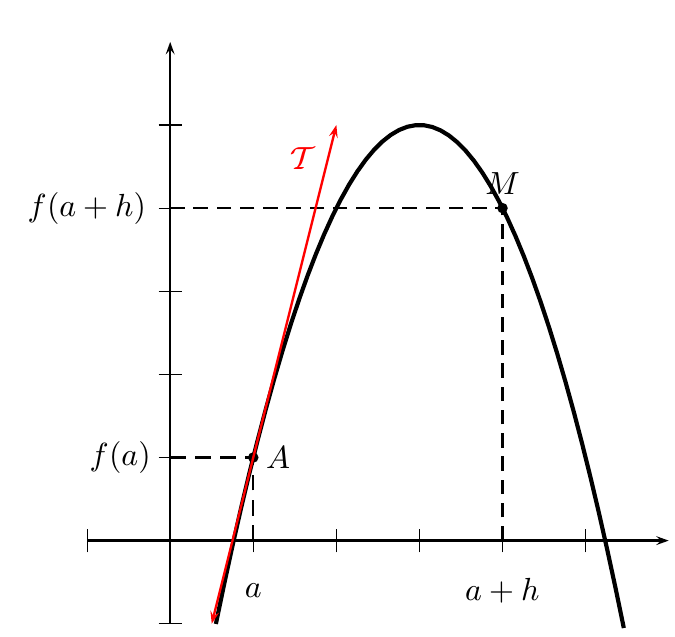

| $$f'(a)=\lim_{h\to\ 0}\frac{f(a+h)-f(a)}{h}.$$ | $$f'(a)=\lim_{x\to\ a}\frac{f(x)-f(a)}{x-a}.$$ |
 Présentation de la dérivabilité
On dit que f'(a) est la le nombre dérivé de f en $a$
$a$ étant un point quelconque $\in\ \mathbb{R}$
Présentation de la dérivabilité
On dit que f'(a) est la le nombre dérivé de f en $a$
$a$ étant un point quelconque $\in\ \mathbb{R}$
 Appliquer la dérivabilité à f(x) = $x^{2}$
Appliquer la dérivabilité à f(x) = $x^{2}$
................................................................................ ................................................................................ ................................................................................
$$f'(a)\ =\ \lim_{h\to\ 0}\frac{f(a+h)-f(a)}{h} $$ pour a = 2 $$f'(2)\ =\ \lim_{h\to\ 0}\frac{f(2+h)-f(2)}{h} $$ $$\Leftrightarrow \ \lim_{h\to\ 0}\frac{(2+h)^{2}\ -\ (2)^2}{h} $$ $$\Leftrightarrow \ \lim_{h\to\ 0}\frac{\left(4\ +\ 4h\ +\ h^2\right) \ -\ 4}{h} $$ $$\Leftrightarrow \ \lim_{h\to\ 0}\frac{4h\ +\ h^2}{h} $$ $$\Leftrightarrow \ \lim_{h\to\ 0} 4\ +\ h \ =\ 4$$ On constate que $ \lim_{x\to\ 2}\frac{f(x)\ -\ f(2)}{x-2} \ =\ 4$ la limite existe et elle est finie. Donc la fonction $x^2$ est bien dérivable en 2.
................................................................................ ................................................................................ ................................................................................
On vient de déterminer que $$\lim_{h\to\ 0}\frac{f(2+h)-f(2)}{h}\ \quad \Leftrightarrow \ \lim_{h\to\ 0} 4\ +\ h \ =\ 4$$ Donc le nombre dérivé de f'(2) est 4.
................................................................................ ................................................................................ ................................................................................
$$f'(a)\ =\ \lim_{h\to\ 0}\frac{f(a+h)-f(a)}{h} $$ pour a = 1 $$f'(1)\ =\ \lim_{h\to\ 0}\frac{f(1+h)-f(1)}{h} $$ $$\Leftrightarrow \ \lim_{h\to\ 0}\frac{\frac{1}{1+h}\ -\ \frac{1}{1}}{h} $$ $$\Leftrightarrow \ \lim_{h\to\ 0}\frac{\frac{1\ -\ \left(1+h\right)}{1+h}}{h} $$ $$\Leftrightarrow \ \lim_{h\to\ 0}\frac{1\ -\ 1-h}{h\left(1+h\right)} $$ $$\Leftrightarrow \ \lim_{h\to\ 0}\frac{-\ h}{h\left(1+h\right)} $$ $$\Leftrightarrow \ \lim_{h\to\ 0} \frac{-1}{1+h} \ =\ -1$$ On constate que $ \lim_{h\to\ 0}\lim_{h\to\ 0}\frac{f(1+h)-f(1)}{h} \ =\ -1$ la limite existe et elle est finie. Donc la fonction $\frac{1}{x}$ est bien dérivable en 1. Le nombre dérivé de g(x) pour a = 1 est noté g'(1) = -1
................................................................................ ................................................................................ ................................................................................
$$f'(a)\ =\ \lim_{x\to\ a}\frac{f(x)-f(a)}{x-a} $$ $$\Leftrightarrow \ \lim_{x\to\ a}\frac{\frac{1}{x}\ -\ \frac{1}{a}}{x-a} $$ $$\Leftrightarrow \ \lim_{x\to\ a}\frac{\frac{a\ -\ x}{a.x}}{x-a} $$ $$\Leftrightarrow \ \lim_{x\to\ a}\frac{a\ -\ x}{x.a\left(x-a\right)} $$ $$\Leftrightarrow \ \lim_{x\to\ a}\frac{-\ 1}{x.a} $$ $$\Leftrightarrow \ \lim_{x\to\ a} \frac{-1}{a.x} \ \ =\ \frac{-1}{a^{2}} $$ On constate que $ \lim_{x\to\ a}\frac{f(x)-f(a)}{x-a} \ =\ \frac{-1}{a^{2}}$. Pour a=0, on obtient $\lim_{x\to\ 0} \frac{-1}{0^{2}}\ =\ +\infty$ la limite n'est pas finie. Donc la fonction $\frac{1}{x}$ n'est pas dérivable en 0.
 Appliquer la dérivabilité à f(x) = $\frac{1}{x}$
Appliquer la dérivabilité à f(x) = $\frac{1}{x}$

 Démonstration de la tangente
Démonstration de la tangente